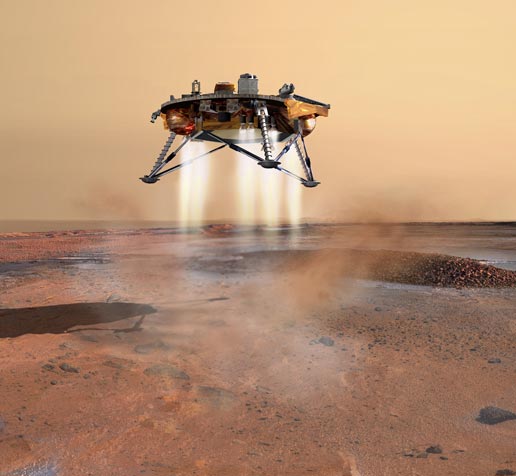The Flight of the Phoenix
Just an hour or so after Scott Dixon earned the checkered flag at the Indianapolis 500, NASA’s robotic spacecraft Phoenix successfully crossed its own finish line as it touched down on the hard scrabble surface of Mars on May 25th. While mission planners did not celebrate with a bottle of milk, they were exuberant as the 422 million-mile-flight came to a perfect close.
“I am in shock,” said Project Manager Barry Goldstein, commenting on how well the mission had gone. After five years of work the team had proven that mistakes can yield progress. But, acknowledged Goldstein, until the spacecraft was on the ground, “we never knew for sure.”
The Entry, Descent, and Landing (EDL) sequence went so smoothly, “it almost looked ‘dry lab,’” reported NASA commentator Robert Shotwell. Phoenix principle investigator Peter Smith of the University of Arizona, Tucson, echoed Shotwell’s surprise at the apparently effortless EDL. “It didn’t seem real,” he marveled.
What was termed the “seven minutes of terror,” where all of the preprogrammed operations must work without glitch and without help from ground controllers, went as flawlessly as Dixon’s final laps. Going from 12,700 miles per hour to 0 in seven minutes is “the most challenging job robotic missions have to do,” according to Fuk Li, Mars program manager at the Jet Propulsion Laboratory (JPL).
“I was right to be optimistic,” Smith noted in a post-touchdown interview. “It’s on a nice flat place, safe and happy.”
Indeed, Phoenix settled on an arctic plain called Vastitas Borealis, comparable in latitude to central Greenland or northern Alaska. In the Martian permafrost the mission will look for evidence of organic molecules and the history of a habitable environment in the planet’s past.
This was the 39th mission to Mars since the first probe was unsuccessfully launched by the USSR in 1960. There have been only 14 previous successes. Phoenix makes NASA and the JPL in Pasadena, the United States’ control center for unmanned space missions, 5 for 5 in Mars missions since 2001.
Launched in August, 2007, Phoenix is the first probe to land in the high latitude “arctic” zone. Its trajectory to Sunday’s landing was coordinated both with the alignments of Earth and Mars as well as the Martian seasons. It is late spring on Mars now. The balmy minus 28-degrees-Fahrenheit summer temperatures (winter temperatures can be almost minus 200 degrees Fahrenheit) are expected to prevail over the mission’s 90-day investigation. After that, dropping temperatures, a carbon dioxide frost and low levels of sunlight will slowly kill the lander’s electronic systems leading to its ultimate end as winter sets in.
Besides being a logistical milestone—one NASA video compared the landing to shooting an arrow from home plate at Dodger Stadium to home plate in Chicago—Phoenix has the capacity to do far more detailed science than previous missions. Not much larger than an office desk or large coffee table, Phoenix is expected to greatly expand our understanding of Mars’ watery history.
For more than a century, Mars has been thought of as the next best place for life in the solar system beyond Earth. From myths of Schiaparelli’s “canals” to H.G. Wells’ War of the Worlds, the idea of life existing on Mars has been a compelling part of our desire to explore the planet. Although our first Viking landers in the 1970s found no conclusive evidence of life, neither did their experiments give completely negative results. Though Phoenix is not designed to search out biological relics per se, it is equipped to discover the most important precursors of life: evidence of liquid water and organic molecules.
According to Douglas McCuiston, Mars program director for NASA, Phoenix is “a major step in our follow-the-water strategy.” The Mars Odyssey orbiter found evidence of water ice mixed with soil just below the surface in 2002. “They have shown us the data,” says McCuiston. Orbital photography and surface rover investigations have confirmed the presence of liquid water in the planet’s history: that water now seems to be frozen just below the surface near the poles.
“For the first time,” McCuiston noted, “humans will be touching water on another planet.”
Like the Viking landers, Phoenix was built to sample the soil at the landing site. It will use a seven-foot retractable scoop to bring material into its onboard laboratories. “We want to dig down,” says investigator Smith, contrasting his plan with the rover missions that continue to roll around on the Martian equator. “I guarantee that there is ice under that surface.”
“This is a scientist’s dream right here on this landing site,” Smith gushed at Sunday night’s press conference.
Smith estimated that it would require a week to teach the mechanical arm where to dig. “It’s a good arm,” he commented, “but it’s an arm. It does not have eyes.” Creating the computer coordination that must exist between the stereographic cameras, the arm and the digging site will require some time.
NASA administrator Michael Griffin one-upped the Phoenix video footage remarking that the precision necessary to put the lander down—not just on Mars, but on the right place on Mars—was 1 part in 10 million. They “make something incredibly hard look easy,” he reiterated.
JPL director Charles Elachi recapitulated simply: “Tonight this team made history,” he said.

